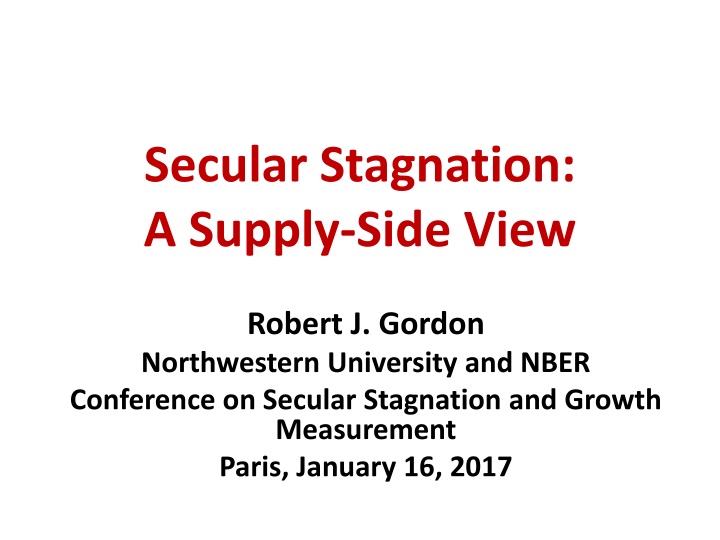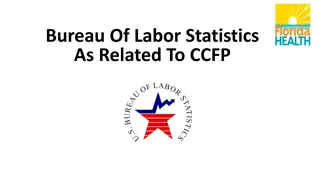
Secular Stagnation: A Supply-Side Perspective
Delve into the origins of secular stagnation from a supply-side view, exploring the impact of slowing productivity growth and declining labor force participation rates on economic output. Learn why this phenomenon matters and how it relates to inadequate aggregate demand according to historical perspectives such as Hansen's theories. Discover the historical context of population growth and the evolution of industrial revolutions contributing to the issue of secular stagnation.
Download Presentation

Please find below an Image/Link to download the presentation.
The content on the website is provided AS IS for your information and personal use only. It may not be sold, licensed, or shared on other websites without obtaining consent from the author. If you encounter any issues during the download, it is possible that the publisher has removed the file from their server.
You are allowed to download the files provided on this website for personal or commercial use, subject to the condition that they are used lawfully. All files are the property of their respective owners.
The content on the website is provided AS IS for your information and personal use only. It may not be sold, licensed, or shared on other websites without obtaining consent from the author.
E N D
Presentation Transcript
Secular Stagnation: A Supply-Side View Robert J. Gordon Northwestern University and NBER Conference on Secular Stagnation and Growth Measurement Paris, January 16, 2017
Origins of Secular Stagnation on the Supply Side Secular Stagnation: slow not no growth Sources emanate from supply side: Hansen in 1938: slowing population growth Today 2015: slowing potential GDP growth 1974-2004: 3.12% Potential Output per Hour Potential Hours of Work Working-age Population Labor-force Participation Rate (LFPR) Difference for Hansen: Productivity growth in late 1930s was very fast, hence his concern about population growth 2004-2015: 1.56%
Why Secular Stagnation Matters Direct AS Effects: low productivity growth, declining LFPR reduce growth in output per capita Indirect Effects: any source of slow potential output growth reduces net investment Basic idea: steady state with fixed long-run capital- output ratio Slower output growth means slower growth in capital Lower net investment: reduces aggregate demand and feeds back to lower productivity growth Hansen 1938: the AD channel from population Today 2015: the AS channel from LFPR and slow productivity growth
For Hansen the Problem Was Inadequate Aggregate Demand
Why Hansen Wasnt Worried About Productivity Growth 4 3.8 3.5 3 2.5 2 1.5 1 0.5 0.2 0 1937-40 2010-16
Slowing Productivity Growth As a Source of Secular Stagnation The best organizing principle to think about innovation is to distinguish among the industrial revolutions (IR #1, IR #2, IR #3). The 1stIR occurred 1770-1840, continued impact through 1900 Steam engine, railroad, steamships Cotton spinning and weaving Transition from wood to steel
The 2ndIR occurred 1870-1920, continued impact through 1970 Electricity, light, elevators, machines, air conditioning Internal combustion engine, vehicles, air transport Telephone, phonograph, movies, radio, TV Running water, sewer pipes, and the conquest of infant mortality Chemicals, plastics, antibiotics, modern medicine Utter change in working conditions, job & home
Third Industrial Revolution Since 1960 the EICT Revolution Entertainment: the evolution of TV from color to time-shifting and streaming Information Tech the evolution from mainframes to PCs, the web, and e-commerce Communications: mobile phones, smart phones Productivity enhancers: ATM, bar-code scanning, fast credit card authorization
The Powerful But Delayed Impact of IR #2 on TFP Growth
Kalman Trends of Labor Productivity and TFP, Private Economy, 1948-2016 LP and TFP Kalman Trends 5 4.5 4 3.5 LP 3 Percent 2.5 TFP 2 1.5 1 0.5 0 1948 1958 1968 1978 1988 1998 2008 Year
IR #3 Has Failed the TFP Test Failure #1: TFP growth post-1970 barely 1/3 of 1920-70 Failure #2: IR #3 boosted TFP growth only briefly 1996-2004 STARTLING QUESTON: HAS MOST OF THE PRODUCTIVITY IMPACT OF THE THIRD INDUSTRIAL REVOLUTION ALREADY HAPPENED?
The IR #3 Changed Business Practices Completely 1970-2005 Transformation in offices completed by 2005. 1970 mechanical calculators, repetitive retyping, file cards, filing cabinets 1970s and 1980s. Memory typewriters, electronic calculators, PCs with word processing and spreadsheets Late 1980s. E-mail, interconnected PCs within firms 1990s. The web, search engines, e-commerce 2000-05 flat screens, home broadband, revolution in business practices was over
The IR #3 Changed Business Practices Completely 1970-2005 Transformation in retailing completed by 2005 1980s and 1990s Wal-Mart led big box revolution in supply chain, inventory management, dynamic pricing Check-out revolution: bar-code scanners, credit/debit card authorization technology
More Achievements Completed by 2005 Finance and Banking 1970s and 1980s, ATM machines 1980s and 1990s. Transition from multi-million share trading days to multi-billion share days
Large Sectors Not Contributing to Productivity Growth Medicine Electronic medical records are here But they have not replaced either doctors nor nurses, complements not substitutes Education Little impact so far of on-line learning in elementary, secondary, or higher education Cost inflation due to bloat of administrative staff
Innovations Continue But How Important Are They? 3-D Printing Greatly speeded up speed and efficiency of designing prototypes, not mass production Robots Robots date back to 1961, by mid-1990s were welding and painting auto bodies Robot description from NYT
Innovations Continue But Are Evolutionary Not Revolutionary Driverless Cars and Trucks Truck drivers don t just drive trucks, they unload them and stock the shelves Artificial Intelligence Predominant uses of big data are in marketing, zero-sum game Evolutionary change: legal searches, radiology reading, voice recognition, language translation
Combined Effects of the Four Headwinds Education headwind reduces productivity growth Demographic headwind reduces hours per person Inequality headwind reduces median growth below average growth Fiscal headwind raises taxes or reduces transfer payments
Figure 18-5. Annual Growth Rate of Alternative Real Income Concepts, Actual Outcomes 1920-2014 and Projected Values 2015-2040 2.5 1920-2014 2.26 2.11 2015-2040 2.0 1.82 1.69 1.5 Percent 1.20 1.0 0.80 0.40 0.5 0.30 0.0 Output per Hour Output per Person Median Output per Person Disposable Median Income Per Person Source: Data underlying Table 18-4.
Conclusions 70 percent of all TFP growth since 1890 occurred 1920-70, attributed to IR #2 The big impacts on TFP of IR #3 were largely completed by 2005 Innovation continues but has less impact Much of the slowdown in future growth is caused by the headwinds A moderate pace of innovation means that jobs will not disappear en masse as predicted by the techno-optimists






















